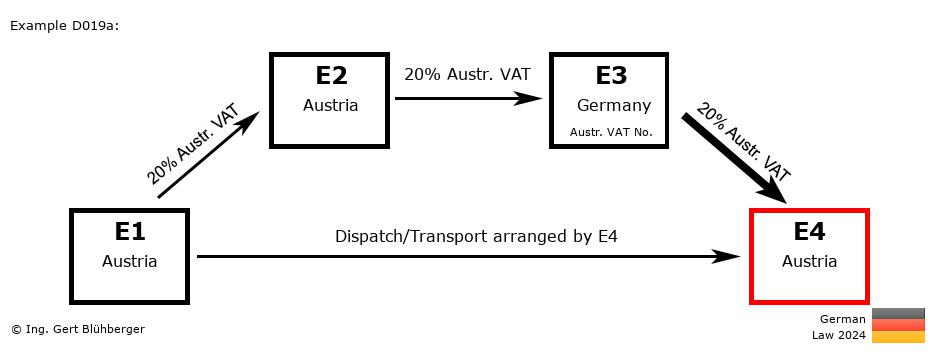Facts:
An Austrian entrepreneur E4 (= last purchaser) orders a machine from his German supplier E3 (=2nd purchaser). The latter in turn orders the machine from the Austrian wholesaler E2 (=1st purchaser). Since the wholesaler E2 does not have the machine in stock, he orders it from the Austrian manufacturer E1 (= first supplier).
The Austrian entrepreneur E4 picks up of the machine from the Austrian manufacturer E1. Brief description of the chain transaction:
- Registration obligations:
- The German entrepreneur E3 has to obtain a VAT registration in the country of departure (Austria).
- "Supply 1" from E1 (Austria) to E2 (Austria)
- Transaction without transport/dispatch assignment (§ 3 (7) UStG)
- Taxable supply in Austria (E1)
- "Supply 2" from E2 (Austria) to E3 (Germany)
- Transaction without transport/dispatch assignment (§ 3 (7) UStG)
- Taxable supply in Austria (E1)
- "Supply 3" from E3 (Germany) to E4 (Austria)
- Assignment of transport or dispatch according to § 3 (6) UStG in conjunction with § 3 (6a) sentence 3 UStG
- Taxable supply in Austria (E1)
- Special feature of this chain transaction
- Since the goods do not leave the country, there is no tax-exempt supply in this chain transaction. All supplies are taxable in Austria.
Detailed description from the perspective of the individual entrepreneurs: From the perspective of the 1st supplier E1 (from Austria): From the perspective of the 1st supplier E1 (from Austria):
Outgoing Invoice:
- Invoicing:
This supply is taxable in Austria (E1). The invoice must therefore be issued with 20 % Austrian VAT, stating the own (Austrian) VAT identification number.
- VAT Return:
Declaration of the sales transaction as a taxable (domestic) supply.
 From the perspective of the 1st purchaser E2 (from Austria): From the perspective of the 1st purchaser E2 (from Austria):
Incoming Invoice:
- VAT return:
The Austrian VAT contained in the incoming invoice can be deducted as input tax and must be included in the VAT return accordingly.
Outgoing Invoice:
- Invoicing:
This supply is taxable in Austria (E1). The invoice must therefore be issued with 20 % Austrian VAT and specification of the own (Austrian) VAT identification number.
- VAT Return:
Declaration of the sales transaction as a taxable (domestic) supply.
 From the perspective of the 2nd purchaser E3 (from Germany): From the perspective of the 2nd purchaser E3 (from Germany):
Registration obligations:- The German entrepreneur E3 has to obtain a VAT registration in the country of departure (Austria) and act with his Austrian VAT identification number towards E2 and E4. The entries listed below are consequently to be included in the Austrian VAT return.
Incoming Invoice:
- VAT return (at the Austrian Tax Office):
The Austrian VAT contained in the incoming invoice can be deducted as input tax and must be included in the VAT return accordingly.
Outgoing Invoice:
- Invoicing:
This supply is taxable in Austria (E1). The invoice must therefore be issued with 20 % Austrian VAT and specification of the own Austrian VAT identification number.
- VAT Return (at the Austrian Tax Office):
Declaration of the sales transaction as a taxable (domestic) supply and payment of the VAT from this supply to the Austrian Tax Office.
 From the perspective of the last purchaser E4 (from Austria): From the perspective of the last purchaser E4 (from Austria):
Incoming Invoice:
- VAT return:
The Austrian VAT contained in the incoming invoice can be deducted as input tax and must be included in the VAT return accordingly.
Notes to the chain transaction:
- The above detailed descriptions from the perspective of the individual entrepreneurs represent only an indication of how the tax assessment would be if the German laws were to apply in Austria. National deviations from the German legislation were also not taken into account in the chain transaction sketch and the brief description!
- In addition to the entries in the VAT return as stated above, the German entrepreneur E3 must record in the German VAT return in line 36/code 45 supplies that are not taxable in Germany whose place of supply is outside Germany and which would be taxable if they would be carried out within the country.
- You can find the German version in the reihengeschaeftrechner.de.
- The assessment of this chain transaction from the Austrian perspective you can find in the reihengeschaeftrechner.at.
Please note the Terms of Use and the Disclaimer of Liability. |

